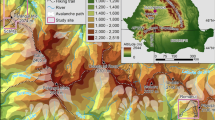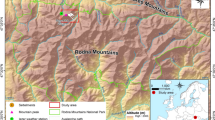Abstract
Snow avalanches pose a considerable risk in the Patagonian Andes. Despite this, avalanche hazard maps are rare for this region. One way to reduce this risk uncertainty is to apply numerical models that predict avalanche runout. These models require that the avalanche release areas must be precisely determined (Maggioni and Gruber 2003) and the friction parameters used by the models must be adjusted to local terrain and snow conditions (Furdada et al. 2002). These parameters can be estimated by simulating avalanche events for which the extent of runout is known. Dendrochronological methods become a valuable tool for precisely defining the spatial extent of past events in the Andes where directly observed evidence is not available. Tree-ring studies are also important for reconstructing years of avalanche occurrences in such cases (Casteller et al. 2008).
Access provided by Autonomous University of Puebla. Download chapter PDF
Similar content being viewed by others
Snow avalanches pose a considerable risk in the Patagonian Andes. Despite this, avalanche hazard maps are rare for this region. One way to reduce this risk uncertainty is to apply numerical models that predict avalanche runout. These models require that the avalanche release areas must be precisely determined (Maggioni and Gruber 2003) and the friction parameters used by the models must be adjusted to local terrain and snow conditions (Furdada et al. 2002). These parameters can be estimated by simulating avalanche events for which the extent of runout is known. Dendrochronological methods become a valuable tool for precisely defining the spatial extent of past events in the Andes where directly observed evidence is not available. Tree-ring studies are also important for reconstructing years of avalanche occurrences in such cases (Casteller et al. 2008).
Here, we present the results of a study related to the largest tragedy in the history of Argentinean mountaineering, in which nine people were killed by a slab avalanche. This occurred on 1 September 2002 at Cerro Ventana, Bariloche, in northern Patagonia (41°12′36″S, 71°22′32″W). Detailed information about the avalanche features were compiled in the field, providing the required inputs to run the avalanche models. As the lower part of the avalanche track is forested by the broadleaf Lenga beech (Nothofagus pumilio), we were able to examine different tree-ring indicators associated with the 2002 event and previous undocumented avalanches at the site. The tree-ring data used to estimate the maximum extent of the 2002 event are verified by the field observations.
Two sampling strategies were applied: (i) purposeful sampling of 15 trees with clear external evidence of past avalanche disturbance along the track, and (ii) systematic sampling of all 24 trees, regardless of the presence of external damage, in a 28 m2 plot located in the run-out zone of the track at 1,455 m elevation. Cross-sections were taken in all cases. In the purposeful sampling, scars from the 2002 avalanche were found in seven of the ten trees sampled between 1,440 and 1,490 m (Fig. 1); none of the five trees below 1,440 m showed damage from the 2002 event. These 15 trees also contained evidence of several earlier avalanche events. In particular, three scars, one variation in eccentricity, and seven abrupt growth changes were noted in 2000. Avalanche events in 1943, 1949, 1978, 1985 and 1991 are also suggested by limited evidence from these trees. Avalanche-damaged trees extend down to 1,380 m, indicating that the 2002 event was not the most extensive from the site. In the systematic sampling, evidence of the 2002 event was recorded in 19 of the 24 sampled trees: seven trees showed scars and 12 unscarred trees showed abrupt growth changes.
(a) Cross section of a Nothofagus pumilio tree damaged by avalanche events in 1998 and 2002. (b) Detail of the eccentricity variation from 1998 and the 2002 scar. (c) Similar growth trends are recorded for both radii prior to the first avalanche impact in 1998. The 2002 avalanche produced the scar shown in (b)
RAMMS is a numerical model for avalanche dynamics (Christen et al. 2008) and was used to simulate the 2002 event. Four simulations were conducted using the observed snow release depth of 0.6 m (release volume of 10,300 m3) and the following coefficients: (a) μ = 0.47, ξ = 1000 m s−2; (b) μ = 0.42, ξ = 1000 m s−2; (c) μ = 0.38, ξ = 1000 m s−2; (d) μ = 0.40, ξ = 700 m s−2, where μ and ξ are the dry and viscous friction coefficients, respectively. An erodible snow layer of 0.6 m was incorporated in Simulation d, which resulted in an additional eroded snow volume of 21,000 m3. The modeled run-out altitude in Simulation c coincides with the dendrochronologically-reconstructed value of 1,440 m, and varies between 40 m upslope and 9 m downslope for Simulations a and d, respectively (Fig. 2). Maximum avalanche velocities provided by the model range from 15.40 to 17.85 m s−1; unfortunately, no recorded avalanche velocities are available for comparison. The maximum simulated snow depths deposited in the track vary from 1.95 to 3.5 m (detail not shown) and are considerably lower than the 7 m observed, even with the model that includes snow entrainment (Simulation d). This limitation reflects the low resolution (30 m) of the topographical model (ASTER DEM), which does not accurately show the terrain features that funneled the avalanche along a narrow path, resulting in lower simulated snow deposition depths and a greater simulated width for the avalanche in the run-out zone.
Four numerical simulations of the 2002 avalanche event (for details see text). The boundary of the 2002 event is shown by a dashed line. The solid lines indicated by 1–1′ show the maximum extent of each simulated event. The extent of the observed and simulated events coincide in figure c. The contour interval is 10 m. The shaded areas within and adjacent to the avalanche track show the modeled distribution and depth of avalanche show (see Casteller et al. 2008)
Our results support previous studies suggesting that tree rings from N. pumilio can be used to date and determine the extent of past snow avalanches (Mundo et al. 2007). Also, though only a preliminary study, this paper demonstrates that tree-ring data can be used to calibrate numerical avalanche models for the Patagonian Andes. Ultimately, advances in snow avalanche modeling and in tree-ring applications will provide regional hazard maps for this mountainous area.
References
Casteller A, Christen M, Villalba R et al (2008) Validating numerical simulations of snow avalanches using dendrochronology: the Cerro Ventana event in Northern Patagonia, Argentina. Nat Haz Earth Syst Sci 8:433–443
Christen M, Bartelt P, Kowalski J et al. (2008) Calculation of dense snow avalanches in three-dimensional terrain with the numerical simulation program RAMMS. In: Gleason JA (ed) Proceedings of the International Snow Science Workshop 2006, Whistler, Canada, pp 709–716
Furdada G, Naaim M, Martinez H (2002) Calibration and application of the MN2D dynamics model to the avalanches of Las Leñas (Argentina). Nat Haz Earth Syst Sci 2:221–226
Maggioni M, Gruber U (2003) The influence of topographic parameters on avalanche release dimension and frequency. Cold Reg Sci Tech 37(3):407–419
Mundo IA, Barrera MD, Roig FA (2007) Testing the utility of Nothofagus pumilio for dating a snow avalanche in Tierra del Fuego, Argentina. Dendrochronologia 25:19–28
Author information
Authors and Affiliations
Corresponding author
Editor information
Editors and Affiliations
Rights and permissions
Copyright information
© 2010 Springer Science+Business Media B.V.
About this chapter
Cite this chapter
Casteller, A., Christen, M., Villalba, R., Stöckli, V. (2010). Using Dendrochronology to Validate Numerical Simulations of Snow Avalanches in the Patagonian Andes. In: Stoffel, M., Bollschweiler, M., Butler, D., Luckman, B. (eds) Tree Rings and Natural Hazards. Advances in Global Change Research, vol 41. Springer, Dordrecht. https://doi.org/10.1007/978-90-481-8736-2_6
Download citation
DOI: https://doi.org/10.1007/978-90-481-8736-2_6
Published:
Publisher Name: Springer, Dordrecht
Print ISBN: 978-90-481-8735-5
Online ISBN: 978-90-481-8736-2
eBook Packages: Earth and Environmental ScienceEarth and Environmental Science (R0)






